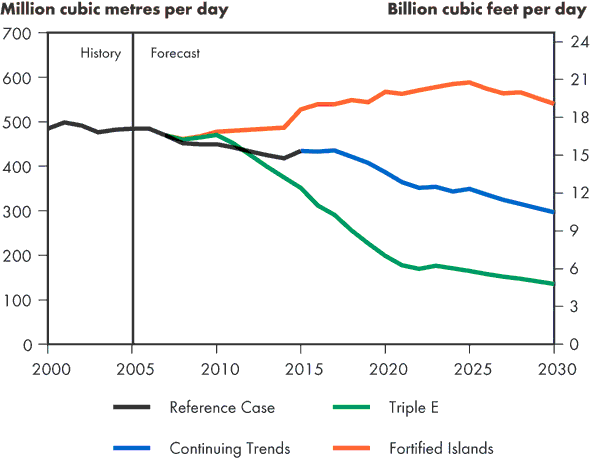ARCHIVED - Fact Sheet - Canada's Energy Future: Reference Case and Scenarios to 2030 - Natural Gas Highlights
This page has been archived on the Web
Information identified as archived is provided for reference, research or recordkeeping purposes. It is not subject to the Government of Canada Web Standards and has not been altered or updated since it was archived. Please contact us to request a format other than those available.
Fact Sheet - Canada's Energy Future: Reference Case and Scenarios to 2030 - Natural Gas Highlights
For decades, virtually all of Canada's natural gas production has come from Western Canada, but that supply is decreasing. Home and business heating will continue to be Canada's largest use of natural gas, but demand growth will come from gas that is used to extract oil from the oil sands and to generate electricity. Although there are challenges, Canada's North, offshore and unconventional gas resources (such as coalbed methane and shale gas) as well as new imports of liquefied natural gas (LNG) will add to supply and meet demand.
1. Conventional natural gas from the Western Canada Sedimentary Basin is declining.
Western Canada is seeing a decline in conventional gas production as older fields become less productive. In the Triple E scenario, gas production in Western Canada would drop by 80 per cent by 2030 from current production levels. This decline is due to lower gas prices which cannot absorb the high costs of producing other gas resources such as unconventional gas or developments in the North.
Canadian Natural Gas Production

The decline in both the Continuing Trends and Fortified Islands scenarios is partially offset by the development of unconventional gas in the region. It is also expected that by 2014 there will be more gas production from the North.
2. Demand for natural gas is growing.
In all of the scenarios, demand for natural gas continues to increase. Home and business heating uses the largest amount of gas in the country. The oilsands and electricity generation are also seeing growth in gas demand. In the Reference Case and Continuing Trends scenarios, gas demand rises 45 per cent between 2005 and 2030 on the strength of gas used in oil sands and electricity generation.
There is a move towards alternatives including fuel substitution and improved efficiency. This is especially true in the Triple E scenario.
3. There may be more natural gas imports than exports by 2030.
In the Triple E scenario, LNG imports account for half of the gas available in Canada by 2030. These imports cost less than developing and bringing northern gas and unconventional gas to market. In both the Continuing Trends and Triple E scenarios, imports gradually come to exceed exports and make Canada a net gas importer before the end of the projection period. In the Fortified Islands scenario, security concerns curb worldwide LNG supply and high prices encourage the development of unconventional and northern gas which allows Canadian gas exports to rise for much of the projection.
Conclusions
Gradual declines in western Canada conventional natural gas production could lead to the development of additional northern, offshore and unconventional gas sources and to imports of LNG. Relatively flat to declining overall production and growing natural gas demand for use in oil sands extraction and electricity generation could eventually diminish Canada's role as a natural gas exporter.
- Date modified:
